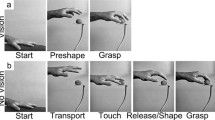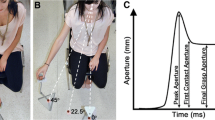Abstract
The Dual Visuomotor Channel theory posits that reaching consists of two movements mediated by separate but interacting visuomotor pathways that project from occipital to parietofrontal cortex. The Reach transports and orients the hand to the target while the Grasp opens and closes the hand for target purchase. Adults rely on foveal vision to synchronize the Reach and the Grasp so that the hand orients, opens, and largely closes by the time it gets to the target. Young infants produce discrete preReach and preGrasp movements, but it is unclear how these movements become synchronized under visual control throughout development. High-speed 3-D video recordings and linear kinematics were used to analyze reaching components, hand orientation, hand aperture, and grasping strategy in infants aged 4–24 months compared with adults who reached with and without vision. Infants aged 4–8 months resembled adults reaching without vision; in that, they delayed both Reach orientation and Grasp closure until after target contact, suggesting that they relied primarily on haptic cues to guide reaching. Infants aged 9–24 months oriented the Reach prior to target contact, but continued to delay the majority of Grasp closure until after target contact, suggesting that they relied on vision for the Reach versus haptics for the Grasp. Changes in sensorimotor control were associated with sequential Reach and Grasp configurations in early infancy versus partially synchronized Reach and Grasp configurations in later infancy. The results argue that (1) haptic inputs likely contribute to the initial development of separate Reach and Grasp pathways in parietofrontal cortex; (2) the Reach and the Grasp are adaptively uncoupled during development, likely to capitalize on different sensory inputs at different developmental stages; and (3) the developmental transition from haptic to visual control is asymmetrical with visual guidance of the Reach preceding that of the Grasp.











Similar content being viewed by others
References
Arbib MA (1981) Perceptual structures and distributed motor control. In: Brooks VB (ed) Handbook of physiology, section 1, vol 2, part 2. American Psychological Society, Bethesda, pp 1449–1480
Barrett TM, Needham A (2008) Developmental differences in infants’ use of an object’s shape to grasp it securely. Dev Psychobiol 50:97–106
Bertenthal B, Von Hofsten C (1998) Eye, head, and trunk control: the foundation for manual development. Neurosci Biobehav Rev 22:515–520
Berthier NE, Carrico RL (2010) Visual information and object size in infant reaching. Infant Behav Dev 33:555–566
Bremner AJ, Hill EL, Pratt M, Rigato S, Spence C (2013) Bodily illusions in young children: developmental change in visual and proprioceptive contributions to perceived hand position. PLoS One 8:e51887
Butterworth G, Verweij E, Hopkins B (1997) The development of prehension in infants: Halverson revisited. Br J Dev Psychol 15:223–236
Carrico RL, Berthier NE (2008) Vision and precision reaching in 15-month-old infants. Infant Behav Dev 31:62–70
Cavina-Pratesi C, Monaco S, Fattori P, Galleti C, McAdam TD, Quinlan DJ, Goodale MA, Culham JC (2010) Functional magnetic resonance imaging reveals the neural substrates of arm transport and grip formation in reach-to-grasp actions in humans. J Neurosci 30:10306–10323
Clifton RK, Muir DW, Ashmead DH, Clarkson MG (1993) Is visually guided reaching in early infancy a myth? Child Dev 64:1099–1110
Corbetta D, Snapp-Childs W (2009) Seeing and touching: the role of sensory-motor experience on the development of infant reaching. Infant Behav Dev 32:44–58
Culham JC, Valyear KF (2006) Human parietal cortex in action. Curr Opin Neurobiol 16:205–212
de Bruin N, Sacrey LA, Brown LA, Doan J, Whishaw IQ (2008) Visual guidance for hand advance but not hand withdrawal in a reach-to-eat task in adult humans: reaching is a composite movement. J Mot Behav 40:337–346
Domellöf E, Hopkins B, Francis B, Rönnqvist L (2007) Effects of finger markers on the kinematics of reaching movements in young children and adults. J Appl Biomech 23:315–321
Eshkol N, Wachman A (1958) Movement notation. Weidenfeld and Nicholson, London
Fagard J (2000) Linked proximal and distal changes in the reaching behavior of 5- to 12-month-old human infants grasping objects of different sizes. Infant Behav Dev 23:317–329
Fiehler K, Rösler F (2010) Plasticity of multisensory dorsal stream functions: evidence from congenitally blind and sighted adults. Restor Neurol Neurosci 28:193–205
Fiehler K, Burke M, Bien S, Röder B, Rösler F (2009) The human dorsal action control system develops in the absence of vision. Cereb Cortex 19:1–12
Filimon F (2010) Human cortical control of hand movements: parietofrontal networks for reaching, grasping, and pointing. Neuroscientist 16:388–407
Foroud A, Whishaw IQ (2012) The consummatory origins of visually guided reaching in human infants: a dynamic integration of whole-body and upper-limb movements. Behav Brain Res 231:343–355
Gharbawie OA, Stepniewska I, Kaas JH (2011) Cortical connections of functional zones in posterior parietal cortex and frontal cortex motor regions in new world monkeys. Cereb Cortex 21:1981–2002
Goodale MA, Milner AD (1992) Separate visual pathways for perception and action. Trends Neurosci 15:20–25
Gori M, Del Viva M, Sandini G, Burr DC (2008) Young children do not integrate visual and haptic form information. Curr Biol 18:694–698
Greenman GW (1963) Visual behavior of newborn infants. In: Solnit AJ, Provence SA (eds) Modern perspectives in child development. Hallmark, New York
Hadders-Algra M (2013) Typical and atypical development of reaching and postural control in infancy. Dev Med Child Neurol 55(Suppl 4):5–8
Hall LA, Karl JM, Thomas BL, Whishaw IQ (2014) Reach and Grasp reconfigurations reveal that proprioception assists reaching and hapsis assists grasping in peripheral vision. Exp Brain Res. doi:10.1007/s00221-014-3945-6
Halverson HM (1931) An experimental study of prehension in infants by means of systematic cinema records. Genet Psychol Monogr 10:107–286
Heck RH, Thomas SL, Tabata LN (2014) Examining individual change with repeated measures data. In: Multilevel and longitudinal modeling with IBM SPSS, 2nd edn. Routledge, New York
Jeannerod M (1981) Intersegmental coordination during reaching at natural visual objects. In: Long J, Badeley A (eds) Attention, performance IX. Lawrence Erlbaum Associates, Hillsdale, pp 153–169
Jeannerod M (1999) Visuomotor channels: their integration in goal-directed prehension. Hum Mov Sci 18:201–218
Karl JM, Whishaw IQ (2013) Different evolutionary origins for the Reach and the Grasp: an explanation for dual visuomotor channels in primate parietofrontal cortex. Front Neurol 4:208
Karl JM, Sacrey LA, Doan JB, Whishaw IQ (2012) Hand shaping using hapsis resembles visually guided hand shaping. Exp Brain Res 219:59–74
Karl JM, Schneider LR, Whishaw IQ (2013) Nonvisual learning of intrinsic object properties in a reaching task dissociates grasp from reach. Exp Brain Res 225:465–477
Konczak J, Dichgans J (1997) The development toward stereotypic arm kinematics during reaching in the first 3 years of life. Exp Brain Res 117:346–354
Kremenitzer JP, Vaughan HG, Kurtzberg D, Dowling K (1979) Smooth-pursuit eye movements in the newborn infant. Child Dev 50:442–448
Lockman JJ, Ashmead DH, Bushnell EW (1984) The development of anticipatory hand orientation during infancy. J Exp Child Psychol 37:176–186
Loenneker T, Klaver P, Bucher K, Lichtensteiger J, Imfeld A, Martin E (2010) Microstructural development: organizational differences of the fiber architecture between children and adults in dorsal and ventral visual streams. Hum Brain Mapp 32:935–946
McCarty ME, Clifton RK, Ashmead DH, Lee P, Goubet N (2001) How infants use vision for grasping objects. Child Dev 72:973–987
Morrongiello BA, Rocca PT (1989) Visual feedback and anticipatory hand orientation during infants’ reaching. Percept Mot Skill 69:787–802
Newell KM, Scully DM, McDonald PV, Baillargeon R (1989) Task constraints and infant grip configurations. Dev Psychobiol 22:817–831
Newell KM, Scully DM, McDonald PV, Baillargeon R (1993) Body scale and infant grip configurations. Dev Psychobiol 26:195–205
Perris E, Clifton R (1988) Reaching in the dark towards sound as a measure of auditory localization in infants. Infant Behav Dev 11:473–492
Rizzolatti G, Luppino G, Matelli M (1998) The organization of the cortical motor system: new concepts. Electroencephalogr Clin Neurophysiol 106:283–296
Robin DJ, Berthier NE, Clifton RK (1996) Infants’ predictive reaching for moving objects in the dark. Dev Psychol 32:824–835
Rönnqvist L, von Hofsten C (1994) Neonatal finger and arm movements as determined by a social and an object context. Early Dev Parent 3:81–94
Sacrey LA, Karl JM, Whishaw IQ (2012) Development of visual and somatosensory attention of the reach-to-eat movement in human infants aged 6 to 12. Exp Brain Res 223:121–136
Schum N, Jovanovic B, Schwarzer G (2011) Ten- and twelve-month-olds’ visual anticipation of orientation and size during grasping. J Exp Child Psychol 109:218–231
Siddiqui A (1995) Object size as a determinant of grasping in infancy. J Genet Psychol 156:345–358
Tanné-Gariépy J, Rouiller EM, Boussaoud D (2002) Parietal inputs to dorsal versus ventral premotor areas in the macaque monkey: evidence for largely segregated visuomotor pathways. Exp Brain Res 145:91–103
Thelen E, Spencer JP (1998) Postural control during reaching in young infants: a dynamic systems approach. Neurosci Biobehav Rev 22:507–514
Thelen E, Corbetta D, Kamm K, Spencer JP, Schneider K, Zernicke RF (1993) The transition to reaching: mapping intention and intrinsic dynamics. Child Dev 64:1058–1098
Thomas BL, Karl JM, Whishaw IQ. The origins of grasping in hand-to-body contacts in human infants during the first 6 months (in preparation)
Twitchell TE (1965) The automatic grasping responses of infants. Neuropsychologia 3:247–259
Van Der Fits IB, Hadders-Algra M (1998) The development of postural response patterns during reaching in healthy infants. Neurosci Biobehav Rev 22:521–526
von Hofsten C (1982) Eye–hand coordination in the newborn. Dev Psychol 18:450–461
von Hofsten C (1984) Developmental changes in the organization of prereaching movements. Dev Psychol 3:378–388
von Hofsten C (1991) Structuring of early reaching movements: a longitudinal study. J Mot Behav 23:280–292
Von Hofsten C, Fazel-Zandy S (1984) Development of visually guided hand orientation in reaching. J Exp Child Psychol 38:208–219
Von Hofsten C, Rönnqvist L (1988) Preparation for grasping an object: a developmental study. J Exp Psychol 14:610–621
von Hofsten C, Rosander K (1997) Development of smooth pursuit tracking in young infants. Vision Res 37:1799–1810
Wallace PS, Whishaw IQ (2003) Independent digit movements and precision grip patterns in 1–5-month-old human infants: hand-babbling, including vacuous then self-directed hand and digit movements, precedes targeted reaching. Neuropsychologia 4:1912–1918
Wentworth N, Benson JB, Haith MM (2000) The development of infants’ reaches for stationary and moving objects. Child Dev 71:576–601
Whishaw IQ, Suchowersky O, Davis L, Sarna J, Metz GA, Pellis SM (2002) Impairment of pronation, supination, and body co-ordination in reach-to-grasp tasks in human Parkinson’s disease (PD) reveals homology to deficits in animal models. Behav Brain Res 133:165–176
White LB, Castle P, Held R (1964) Observations on the development of visually-directed reaching. Child Dev 35:349–364
Witherington DC (2005) The development of prospective grasping control between 5 and 7 months: a longitudinal study. Infancy 7:143–161
Acknowledgments
The authors would like to thank the infants and their parents for agreeing to participate in this study and Lauren A. Hall for help with data analysis and figure preparation. This research was supported by the Natural Sciences and Engineering Research Council of Canada (JMK, IQW), Alberta Innovates-Health Solutions (JMK), and the Canadian Institutes of Health Research (IQW).
Author information
Authors and Affiliations
Corresponding author
Electronic supplementary material
Below is the link to the electronic supplementary material.
Supplementary material 1 (MOV 2529 kb)
Supplementary material 2 (MOV 623 kb)
Supplementary material 3 (MOV 1061 kb)
Supplementary material 4 (MOV 764 kb)
Supplementary material 5 (MOV 1137 kb)
Supplementary material 6 (MOV 3009 kb)
Supplementary material 7 (MOV 675 kb)
Rights and permissions
About this article
Cite this article
Karl, J.M., Whishaw, I.Q. Haptic grasping configurations in early infancy reveal different developmental profiles for visual guidance of the Reach versus the Grasp. Exp Brain Res 232, 3301–3316 (2014). https://doi.org/10.1007/s00221-014-4013-y
Received:
Accepted:
Published:
Issue Date:
DOI: https://doi.org/10.1007/s00221-014-4013-y




